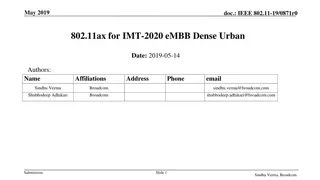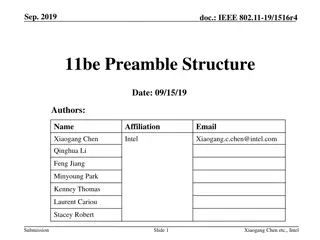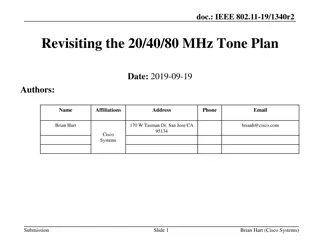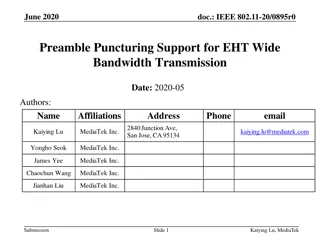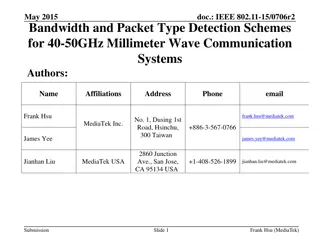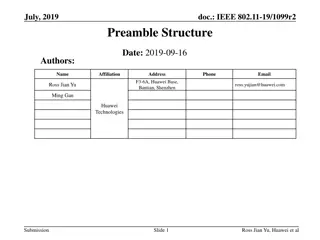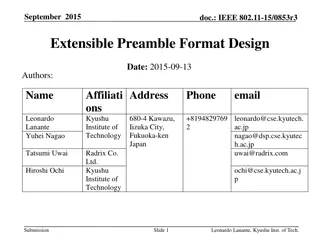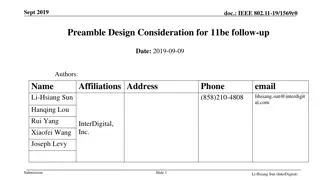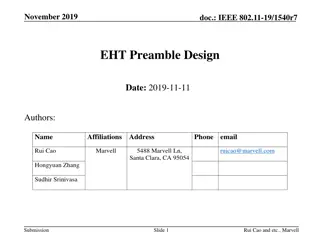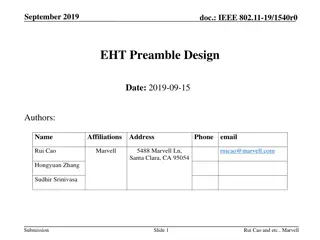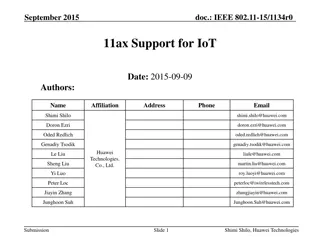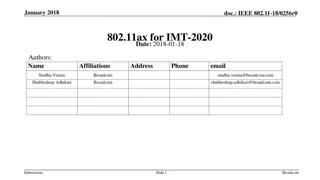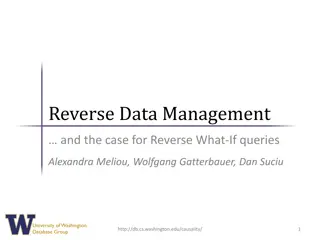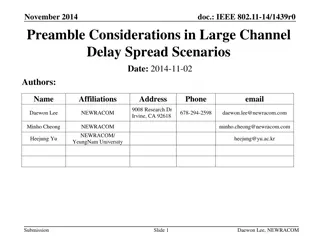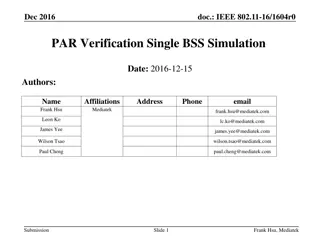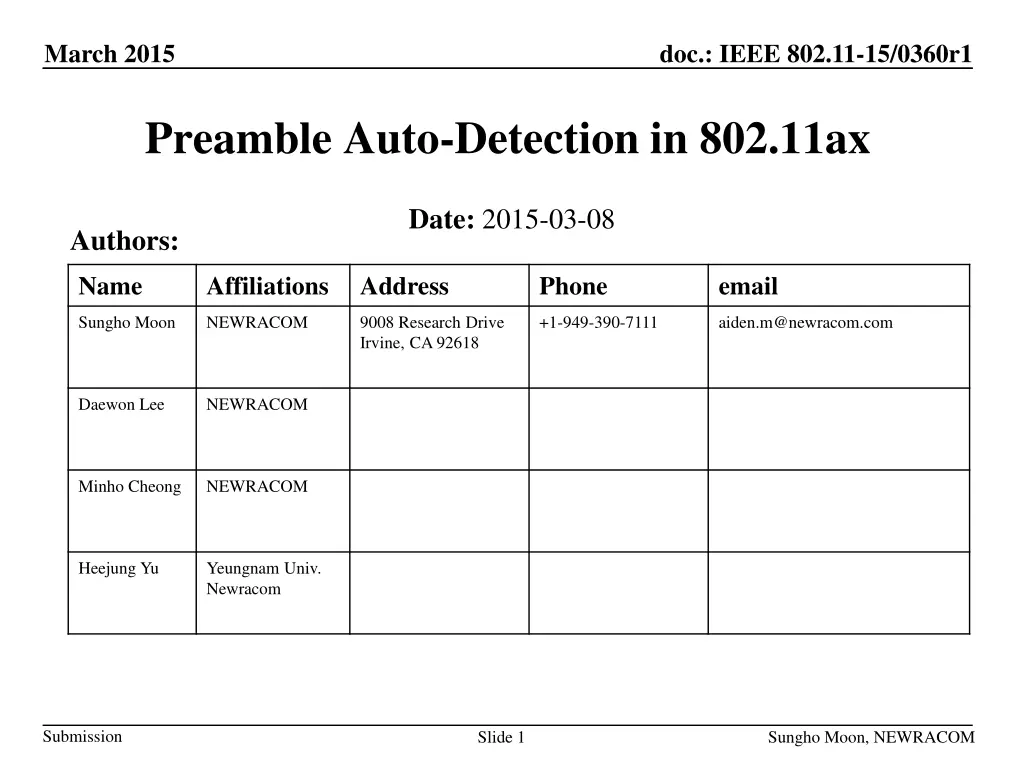
Auto-Detection in IEEE 802.11ax: Design and Modulation Strategies
Explore the auto-detection mechanisms in IEEE 802.11ax for different PPDU types like 11n, 11ac, and the new HE devices. The design constraints, modulation choices, and candidate options for HE SIG-A are discussed to ensure efficient detection while maintaining compatibility with existing devices.
Download Presentation

Please find below an Image/Link to download the presentation.
The content on the website is provided AS IS for your information and personal use only. It may not be sold, licensed, or shared on other websites without obtaining consent from the author. If you encounter any issues during the download, it is possible that the publisher has removed the file from their server.
You are allowed to download the files provided on this website for personal or commercial use, subject to the condition that they are used lawfully. All files are the property of their respective owners.
The content on the website is provided AS IS for your information and personal use only. It may not be sold, licensed, or shared on other websites without obtaining consent from the author.
E N D
Presentation Transcript
March 2015 doc.: IEEE 802.11-15/0360r1 Preamble Auto-Detection in 802.11ax Date: 2015-03-08 Authors: Name Affiliations Address Phone email Sungho Moon NEWRACOM 9008 Research Drive Irvine, CA 92618 +1-949-390-7111 aiden.m@newracom.com Daewon Lee NEWRACOM Minho Cheong NEWRACOM Heejung Yu Yeungnam Univ. Newracom Submission Slide 1 Sungho Moon, NEWRACOM
March 2015 doc.: IEEE 802.11-15/0360r1 Introduction Preamble Auto-Detection for 11n and 11ac 11n PPDUs have the unique modulation QBPSK in SIG-A1 11ac PPDUs can be detected in the position of SIG-A2 QBPSK in SIG-A2 can differentiate 11ac PPDUs with 11a s PPDU type L-SIG SIG-A1 SIG-A2 Data/STF/SIG- A3 11a BPSK Data Data Data 11n BPSK QBPSK QBPSK HT-STF 11ac BPSK BPSK ? QBPSK ? VHT-STF ? 11ax BPSK Submission Slide 2 Sungho Moon, NEWRACOM
March 2015 doc.: IEEE 802.11-15/0360r1 Design Constraints for HE Auto-Detection HE PPDUs should not affect any to previous 11a, 11n, and 11ac devices HE device should detect 11ax PPDU with a reasonable detection probability HE devices should detect types of PPDU before receiving STF (be ready for AGC). At the very least do not require too much buffering for AGC tuning. Submission Slide 3 Sungho Moon, NEWRACOM
March 2015 doc.: IEEE 802.11-15/0360r1 HE SIG-A Modulation for Auto-Detection Basic assumption More priority to use BPSK and QBPSK considering Euclidean distance with existing SIG-A modulations Other types of modulations such as 45 degree I/Q can be utilized as a second priority if there is no choice in the BPSK/QBPSK combinations Therefore, for each symbol position of HE SIG-A HE SIG-A1 and SIG-A2 can be BPSK and BPSK, respectively or QBPSK and BPSK unless it increases the false-detection probability for 11n devices If three or more symbols of HE SIG-A is agreed, QBPSK could be a better choice for the third HE SIG-A symbols as it does not overlap with STF modulation or Data modulations. Submission Slide 4 Sungho Moon, NEWRACOM
March 2015 doc.: IEEE 802.11-15/0360r1 HE SIG-A Candidates Option 1: (BPSK, BPSK, QBPSK) There might be less impact on the detection in 11n devices since the uniqueness of QBPSK is maintained in the first symbol 11ax devices can prepare for 11n or 11ac AGC because non-11ax PPDU can be determined during the second SIG-A symbol position Option 2: (QBPSK, BPSK, QBPSK) QBPSK and BPSK in the first and second SIG-A symbols are exclusive to other modulations If two symbols of HE SIG-A considered, (QBPSK, BPSK) can be used without the third QBPSK Submission Slide 5 Sungho Moon, NEWRACOM
March 2015 doc.: IEEE 802.11-15/0360r1 Simulation Environment Wireless channel TGac D and ITU UMa channels (for outdoor) System parameters PPDU format : 11ax with Option 1(B, B, Q) and with Option 2(Q, B, Q) I/Q decision algorithm : Accumulated energy in I- and Q-axis PPDU format detection algorithm : Symbol-by-Symbol and Joint Performance metrics Miss-detection probability in 11ax devices False detection probability in 11a, 11n, and 11ac devices False detection only occurs if the wrong PPDU format is detected and SIG CRC passes based on the detected PPDU format. Submission Slide 6 Sungho Moon, NEWRACOM
March 2015 doc.: IEEE 802.11-15/0360r1 Mis-Detection & SIG-A Performance Observations Both options have comparable performance with 11ac Submission Slide 7 Sungho Moon, NEWRACOM
March 2015 doc.: IEEE 802.11-15/0360r1 False Detection in 11ax Devices Observation For both detection algorithms, i.e., symbol-by-symbol and joint, reliable false detection probabilities are maintained Submission Slide 8 Sungho Moon, NEWRACOM
March 2015 doc.: IEEE 802.11-15/0360r1 Mis- and False Detections in Outdoor Environments Observations In the outdoor environment, no problem has been seen in our simulation results Submission Slide 9 Sungho Moon, NEWRACOM
March 2015 doc.: IEEE 802.11-15/0360r1 False Detection in 11n Devices Observation If 11n device detects 11n PPDUs in symbol-by-symbol, it results in false format detection of 11ax PPDU. This results in constant 0.4% false detection of 11n regardless of SNR, which is equivalent to the CRC false detection bound (1/28) Note that 0.4% false detection of 11n may or may not be an issue. Further study on the impact of 11n false detection to system performance is needed. Submission Slide 10 Sungho Moon, NEWRACOM
March 2015 doc.: IEEE 802.11-15/0360r1 False Detection in 11ac Devices Observation No degradation in false detection of 11ac PPDU, but the same problem can occur in 11n PPDU detection Submission Slide 11 Sungho Moon, NEWRACOM
March 2015 doc.: IEEE 802.11-15/0360r1 Conclusion If three or more symbols for SIG-A is considered, (BPSK, BPSK, QBPSK) can be a reasonable option It shows a comparable mis-detection and false detection probabilities with 11ac in both indoor and outdoor environments There is no impact on the false detection probability in 11a, 11n, 11ac devices The modulation starting from (QBPSK, BPSK, ~) can cause undefined operations in 11n devices due to a falsely detected SIG-A in 11n devices in approximately 0.4 % of the time. Note that in some cases, L-SIG length may provide the required medium access protection for falsely detected 11ax packets. If two symbols for SIG-A is considered, further investigation on impact to system performance when false detection of 11ax as 11n is approximately 0.4% will be required. If significant problem are found with false detection, other types of auto-detection methods will be required to avoid the above problem Submission Slide 12 Sungho Moon, NEWRACOM
March 2015 doc.: IEEE 802.11-15/0360r1 Straw Poll #1 Do you agree that HE-SIG-A shall consist of three 4us OFDM symbols. Submission Slide 13 Sungho Moon, NEWRACOM
March 2015 doc.: IEEE 802.11-15/0360r1 Straw Poll #2 Do you agree that HE-SIG-A shall consist of two 4us OFDM symbols. Submission Slide 14 Sungho Moon, NEWRACOM
March 2015 doc.: IEEE 802.11-15/0360r1 Straw Poll #3 Do you agree that three HE-SIG-A symbols are modulated by BPSK, BPSK, and QBPSK, respectively. Submission Slide 15 Sungho Moon, NEWRACOM
March 2015 doc.: IEEE 802.11-15/0360r1 References [1] Il-Gu Lee, et. al., 802.11ac preamble for VHT auto-detection, 11- 10/0359r0, March 2010. [2] Hongyuan Zhang, et. al., TGac Preamble Auto-detection Comparisons, 11-10/0549r2, May 2010. [3] Vish Ponnampalam, et. al., 11ac Auto-Detection Using the VHT-SIG-A Field, 11-10/0750r0, July 2010. [4] Jaeyoung Song, et. al., Considerations on 11ax Auto-detection Methods, 11-14/0081r1, Jan. 2015. [5] IEEE Std 802.11ac -2013 Submission Slide 16 Sungho Moon, NEWRACOM


